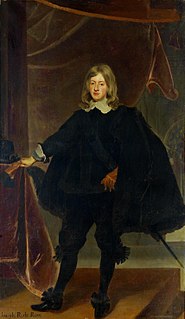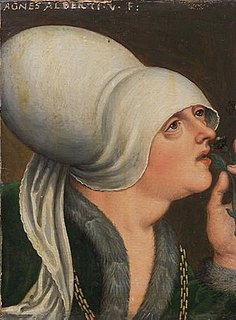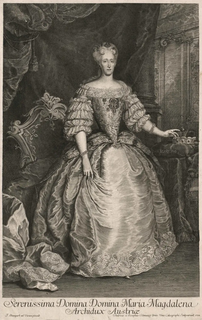Related Research Articles

Ferdinand IV was made and crowned King of Bohemia in 1646, King of Hungary and Croatia in 1647, and King of the Romans on 31 May 1653. He also served as Duke of Cieszyn.

Leopold V, Archduke of Further Austria was the son of Archduke Charles II of Inner Austria, and the younger brother of Emperor Ferdinand II, father of Ferdinand Charles, Archduke of Further Austria. He was Bishop of Passau and of Strasbourg, until he resigned to get married, and Archduke of Further Austria including Tirol.

Maria Anna of Bavaria was a politically active Archduchess of Austria by marriage to Archduke Charles II of Austria. She played an important role in the counter reformation in Austria.

Elizabeth of Austria was the wife of King Casimir IV of Poland and thus Queen of Poland and Grand Duchess of Lithuania. Orphaned at an early age, she spent her childhood in the court of Holy Roman Emperor Frederick III. As one of the three surviving grandchildren of Emperor Sigismund, she had a strong claim to the kingdoms of Hungary and Bohemia. That made her an attractive bride for a Polish prince. The Polish nobility, seeking to increase Polish influence in Hungary and Bohemia, pursued marriage with Elizabeth since she was born and finally succeeded in 1454. Her marriage to Casimir was one of the most successful royal marriages in Poland. She gave birth to thirteen children, eleven of whom survived to adulthood. Four of her sons were crowned as kings.

Anne of Bohemia and Austria was a Duchess of Luxembourg in her own right and, as a consort, Landgravine of Thuringia and of Saxony.
Henry, of the House of Ardenne–Luxembourg, was the count of Luxembourg from 998 and the duke of Bavaria from 1004. He was the son of Siegfried I of Luxembourg and Hedwige of Nordgau.

Rudolf of Zähringen was the archbishop of Mainz from 1160 to 1161 and prince-bishop of Liège. He was the son of Conrad I of Zähringen and Clemence of Luxembourg-Namur.

Maria Magdalena, Archduchess of Austria was a daughter of Emperor Leopold I and his third wife Eleonore Magdalene of the Palatinate. She died unmarried.

Charles Joseph was an Archduke of Austria and Grand Master of the Teutonic Knights (1662–64). He was also the bishop of Olmütz, and Breslau, Passau.

Magnus II, Duke of Mecklenburg-Schwerin and Güstrow was duke of Mecklenburg-Schwerin from 1477 until his death.

John Casimir, Count Palatine of Zweibrücken-Kleeburg was the son of John I, Count Palatine of Zweibrücken and his wife, Duchess Magdalene of Jülich-Cleves-Berg and was the founder of a branch of Wittelsbach Counts Palatine often called the Swedish line, because it gave rise to three subsequent kings of Sweden, but more commonly known as the Kleeburg line.

Archduchess Gregoria Maximiliana of Austria was a member of the House of Habsburg.

Maximilian Ernest of Austria, was an Austrian prince member of the House of Habsburg and by birth Archduke of Austria.

Albert I, called the Proud, a member of the House of Wettin, was the Margrave of Meissen from 1190 until his death.

Charles of Austria, nicknamed the Posthumous, a member of the Imperial House of Habsburg, was Prince-Bishop of Wrocław (Breslau) from 1608, Prince-Bishop of Brixen from 1613, and Grand Master of the Teutonic Order from 1618 until his death. In 1621 he also received the Bohemian County of Kladsko as a fief from the hands of his brother, Emperor Ferdinand II.

Anna Jagiellon, was a Polish princess member of the Jagiellonian dynasty and by marriage Duchess of Pomerania.
Adalbert III of Bohemia, also called Vojtěch in Bohemia, was Archbishop of Salzburg between 1168 and 1177 and then again between 1183 and 1200. His reign is marked significantly from the struggle with Emperor Frederick I Barbarossa. He is listed as a Blessed of the Premonstratensians.

Rudolf III von Montfort was bishop of Chur (1322–1325) and Konstanz (1322–1334). He was born into the young family of Montfort-Feldkirch of the Swabian noble family of Montfort.
The History of the Expedition of the Emperor Frederick is an anonymous Latin account of the campaign waged by Frederick I, Holy Roman Emperor, as part of the Third Crusade. It covers the period 1187–1196, but is centred on the expedition of 1189–1190.

Konrad von Burgsdorff (1595-1652) was a Chief Chamberlain and Privy Councilor for the Electorate of Brandenburg, in command of all the fortresses there, and a Knight in the Order of Saint John. He was also a member of the Fruitbearing Society, devoted to standardizing the German language.
References
- ↑ Norbert Kössinger (2016), "Magnus of Reichersberg", in Graeme Dunphy and Cristian Bratu (eds.), Encyclopedia of the Medieval Chronicle , Brill Online.
- 1 2 3 Ludwig Holzfurtner (1987), "Magnus von Reichersberg", Neue Deutsche Biographie (in German), vol. 15, Berlin: Duncker & Humblot, pp. 671–672; ( full text online ).
- ↑ Wilhelm Wattenbach (1884), "Magnus von Reichersberg", Allgemeine Deutsche Biographie (ADB) (in German), vol. 20, Leipzig: Duncker & Humblot, p. 75.
- 1 2 Graham Loud, ed. (2010), The Crusade of Frederick Barbarossa: The History of the Expedition of the Emperor Frederick and Related Texts, Ashgate, pp. 4–5.